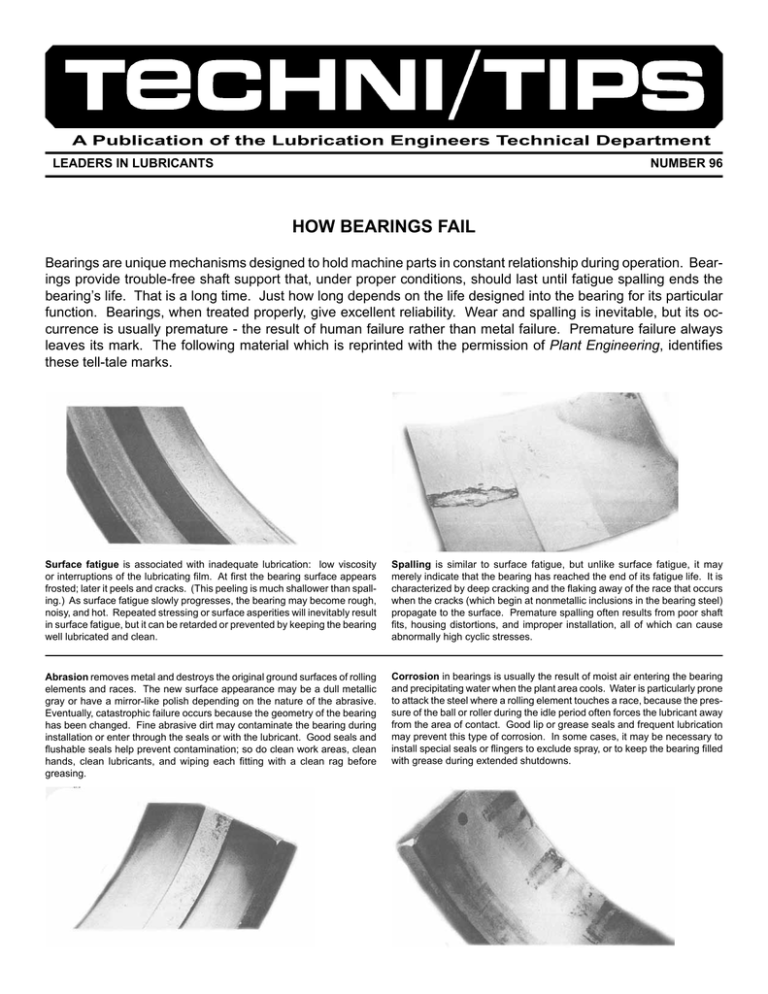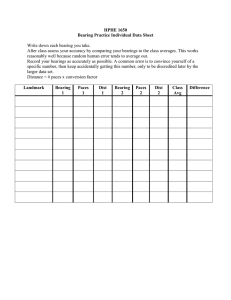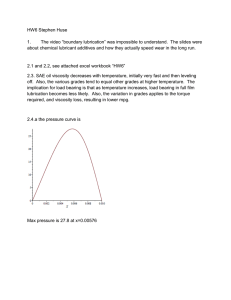how bearings fail - Lubrication Engineers
advertisement

A Publication of the Lubrication Engineers Technical Department LEADERS IN LUBRICANTS NUMBER 96 HOW BEARINGS FAIL Bearings are unique mechanisms designed to hold machine parts in constant relationship during operation. Bearings provide trouble-free shaft support that, under proper conditions, should last until fatigue spalling ends the bearing’s life. That is a long time. Just how long depends on the life designed into the bearing for its particular function. Bearings, when treated properly, give excellent reliability. Wear and spalling is inevitable, but its occurrence is usually premature - the result of human failure rather than metal failure. Premature failure always leaves its mark. The following material which is reprinted with the permission of Plant Engineering, identifies these tell-tale marks. Surface fatigue is associated with inadequate lubrication: low viscosity or interruptions of the lubricating film. At first the bearing surface appears frosted; later it peels and cracks. (This peeling is much shallower than spalling.) As surface fatigue slowly progresses, the bearing may become rough, noisy, and hot. Repeated stressing or surface asperities will inevitably result in surface fatigue, but it can be retarded or prevented by keeping the bearing well lubricated and clean. Spalling is similar to surface fatigue, but unlike surface fatigue, it may merely indicate that the bearing has reached the end of its fatigue life. It is characterized by deep cracking and the flaking away of the race that occurs when the cracks (which begin at nonmetallic inclusions in the bearing steel) propagate to the surface. Premature spalling often results from poor shaft fits, housing distortions, and improper installation, all of which can cause abnormally high cyclic stresses. Abrasion removes metal and destroys the original ground surfaces of rolling elements and races. The new surface appearance may be a dull metallic gray or have a mirror-like polish depending on the nature of the abrasive. Eventually, catastrophic failure occurs because the geometry of the bearing has been changed. Fine abrasive dirt may contaminate the bearing during installation or enter through the seals or with the lubricant. Good seals and flushable seals help prevent contamination; so do clean work areas, clean hands, clean lubricants, and wiping each fitting with a clean rag before greasing. Corrosion in bearings is usually the result of moist air entering the bearing and precipitating water when the plant area cools. Water is particularly prone to attack the steel where a rolling element touches a race, because the pressure of the ball or roller during the idle period often forces the lubricant away from the area of contact. Good lip or grease seals and frequent lubrication may prevent this type of corrosion. In some cases, it may be necessary to install special seals or flingers to exclude spray, or to keep the bearing filled with grease during extended shutdowns. Fretting looks much like rust. It occurs in bores, on shafts and on other mating surfaces. It is caused by slight (even microscopic) movements under load. The wear particles are black if air has been excluded, red if it has not. Fretting can make the inner ring loosen on the shaft or “freeze” it so it cannot be removed; fretting can also cause the ring to break. It can be prevented by fitting parts too tightly to move under load; the manufacturer’s recommended tolerances should be followed. True brinelling consists of indentations in the races that are plastic deformations of the metal grinding marks are still visible in the dents. True brinelling can result from high static of impact loads, poor mounting practices, or dropping the machinery. Brinelling at installation can be prevented by applying force only to the part to be press fitted. If impact loads cannot be prevented or cushioned, bearings with higher static ratings must be used. False brinelling is produced by the removal of metal. A close inspection shows no grind marks in the depression; the bottom of the depression is often discolored. False brinelling results from vibration of a bearing at rest, often during transport. It can also occur when equipment that is not in operation is shaken by operating equipment. Properly blocking shafts during shipment and isolating equipment from vibration will prevent false brinelling. Separate bases may be needed. Electrical fluting develops in a regular pattern over race and rolling element surfaces as a result of the passage of an electrical current through the bearing. (Electrical pitting, which has the same cause, develops randomly.) Static electricity generated by conveyor belts and current from careless welding setups are the most common causes. Conveyors should be equipped with grounding straps; welds should be grounded between the weld and the closest bearing. Smearing is the metal removed from one surface and deposited on another. It is caused by sliding under heavy load with insufficient lubrication. The ends of cylindrical rollers sometimes exhibit smearing, indicating that the cylindrical roller bearing is receiving a thrust load, which this type of bearing is not designed to carry. Smearing may also be caused by mishandling. When smearing occurs in a correctly applied bearing, poor lubrication is often the problem. Scoring is abrasive wear in the form of deep scratches in the rolling elements and races. It is sometimes called “wire drawing.” The score marks create stress concentrations that soon result in surface fatigue. Scoring is caused by relatively large particles that become trapped in the bearing and are driven around the races by the rollers. Like other forms of contamination, scoring can be prevented by good seals and frequent relubrication with clean oil or grease. Debris denting is similar to true brinelling in that indentations are the result of plastic flow rather than wear. But debris denting occurs while the bearing is running. Foreign matter is actually rolled into the races by the balls or rollers, leaving random dents that can cause surface fatigue because they act as stress risers and disrupt the lubricant film. Debris denting can be reduced by better seals and more frequent relubrication, which will flush foreign matter away. Assembly damage can take many forms. The part shown is the inner ring of a separable cylindrical roller bearing. The ring was cocked during installation; when it was forced in the cocked position, the rollers gouged the metal. (The cold flow of metal can also be caused by severe overloading. If the bearing was stationary, the damage is called true brinelling. Cold flow in operation results from gross overloading. Hot working is a change in bearing geometry accomplished by a combination of heat and load. It is usually associated with complete or catastrophic failure. In some cases, the heat is generated within the bearing by lack of lubrication, friction from a ring turning on the shaft or in the housing, or excessive speed. In others, the heat enters the bearing from an external source, such as a heat-treating furnace. Sometimes two or more causes act together. Bending is the permanent deformation of soft metal (not heat-treated) bearing components, such as retainers, seal carriers, flingers, and shields. In general, rings and rollers cannot be bent because the steel is too hard (see the photograph showing a broken inner ring.) In most instances, bending is caused by improper handling of the bearing or the part during installation or storage, but it may also be caused by an earlier failure of another type. Fracture of the inner ring of collar-mounted bearings is often caused by a cam failure or by a crack originating at a set-screw hole. In many cases, these failures can be traced to an undersized shaft, overtightening, or both. Occasionally, nicks on the shaft create stress concentrations large enough to break the inner ring; an interference fit between the bearing and an oversized shaft or cocking during installation can cause the inner ring to break from hoop stress. Broken pillow-block housings like this one have usually failed because of overloading or shock. Cap breaks are generally caused by upward acting loads; they are most common when the cap material is cast iron. When upward acting loads are unavoidable and they exceed 10 percent of the bearing’s dynamic load rating, a cast steel pillow-block should be used. Pillow-block feet may snap off if the mounting surface is not flat to 0.0004 in./in. or if the bolts are too tight or too loose. Retainer failures often lead to ring fracture or separation, followed by catastrophic failure, which may obscure the retainer that was the original problem. The most common cause of these failures in ball bearings is the flexing that takes place when the balls move in a criss-cross pattern because of misalignment. Retainer failures in other types of bearings are usually caused by handling damage, contamination, or marginal lubrication. 300 Bailey Avenue, Fort Worth, TX 76107 l 817-916-3200 l 800-537-7683 fax 817-834-2431 l http://www.le-inc.com LI 20096 02-94

